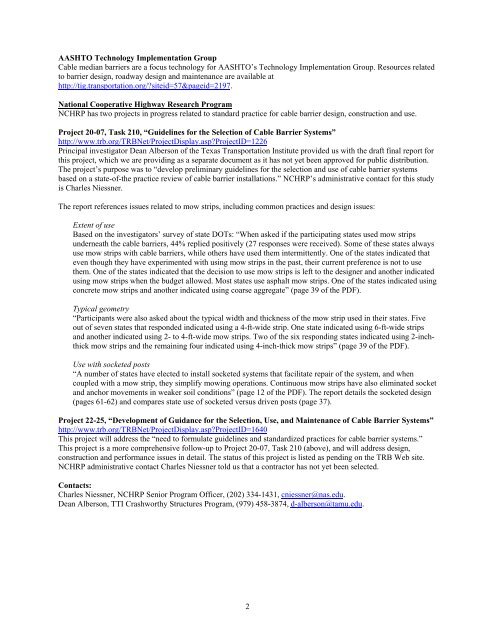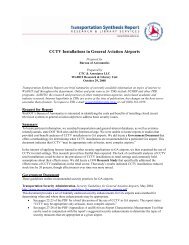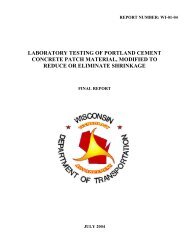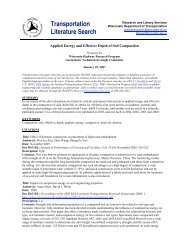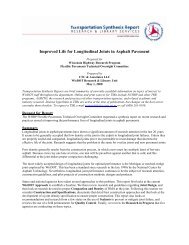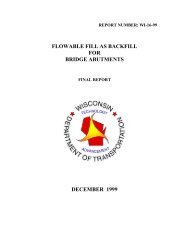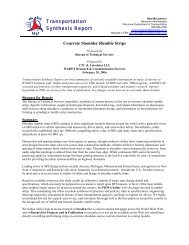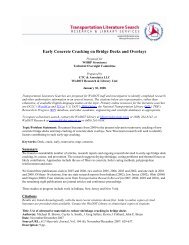Mow Strip Design and Practices - WisDOT Research
Mow Strip Design and Practices - WisDOT Research
Mow Strip Design and Practices - WisDOT Research
You also want an ePaper? Increase the reach of your titles
YUMPU automatically turns print PDFs into web optimized ePapers that Google loves.
AASHTO Technology Implementation GroupCable median barriers are a focus technology for AASHTO’s Technology Implementation Group. Resources relatedto barrier design, roadway design <strong>and</strong> maintenance are available athttp://tig.transportation.org/?siteid=57&pageid=2197.National Cooperative Highway <strong>Research</strong> ProgramNCHRP has two projects in progress related to st<strong>and</strong>ard practice for cable barrier design, construction <strong>and</strong> use.Project 20-07, Task 210, “Guidelines for the Selection of Cable Barrier Systems”http://www.trb.org/TRBNet/ProjectDisplay.asp?ProjectID=1226Principal investigator Dean Alberson of the Texas Transportation Institute provided us with the draft final report forthis project, which we are providing as a separate document as it has not yet been approved for public distribution.The project’s purpose was to “develop preliminary guidelines for the selection <strong>and</strong> use of cable barrier systemsbased on a state-of-the practice review of cable barrier installations.” NCHRP’s administrative contact for this studyis Charles Niessner.The report references issues related to mow strips, including common practices <strong>and</strong> design issues:Extent of useBased on the investigators’ survey of state DOTs: “When asked if the participating states used mow stripsunderneath the cable barriers, 44% replied positively (27 responses were received). Some of these states alwaysuse mow strips with cable barriers, while others have used them intermittently. One of the states indicated thateven though they have experimented with using mow strips in the past, their current preference is not to usethem. One of the states indicated that the decision to use mow strips is left to the designer <strong>and</strong> another indicatedusing mow strips when the budget allowed. Most states use asphalt mow strips. One of the states indicated usingconcrete mow strips <strong>and</strong> another indicated using coarse aggregate” (page 39 of the PDF).Typical geometry“Participants were also asked about the typical width <strong>and</strong> thickness of the mow strip used in their states. Fiveout of seven states that responded indicated using a 4-ft-wide strip. One state indicated using 6-ft-wide strips<strong>and</strong> another indicated using 2- to 4-ft-wide mow strips. Two of the six responding states indicated using 2-inchthickmow strips <strong>and</strong> the remaining four indicated using 4-inch-thick mow strips” (page 39 of the PDF).Use with socketed posts“A number of states have elected to install socketed systems that facilitate repair of the system, <strong>and</strong> whencoupled with a mow strip, they simplify mowing operations. Continuous mow strips have also eliminated socket<strong>and</strong> anchor movements in weaker soil conditions” (page 12 of the PDF). The report details the socketed design(pages 61-62) <strong>and</strong> compares state use of socketed versus driven posts (page 37).Project 22-25, “Development of Guidance for the Selection, Use, <strong>and</strong> Maintenance of Cable Barrier Systems”http://www.trb.org/TRBNet/ProjectDisplay.asp?ProjectID=1640This project will address the “need to formulate guidelines <strong>and</strong> st<strong>and</strong>ardized practices for cable barrier systems.”This project is a more comprehensive follow-up to Project 20-07, Task 210 (above), <strong>and</strong> will address design,construction <strong>and</strong> performance issues in detail. The status of this project is listed as pending on the TRB Web site.NCHRP administrative contact Charles Niessner told us that a contractor has not yet been selected.Contacts:Charles Niessner, NCHRP Senior Program Officer, (202) 334-1431, cniessner@nas.edu.Dean Alberson, TTI Crashworthy Structures Program, (979) 458-3874, d-alberson@tamu.edu.2


